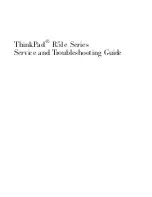
Appendix D.
An Introduction to Disk Partitions
Note
This appendix is not necessarily applicable to non-x86-based architecures. However, the general
concepts mentioned here may apply.
Disk partitions are a standard part of the personal computer landscape and have been for quite some
time. However, with many people purchasing computers featuring pre-installed operating systems,
relatively few people understand how partitions work. This chapter attempts to explain the reasons for
and use of disk partitions so your Red Hat Enterprise Linux installation is as simple and painless as
possible.
If you are reasonably comfortable with disk partitions, you could skip ahead to Section D.1.4
Making
Room For Red Hat Enterprise Linux
, for more information on the process of freeing up disk space to
prepare for a Red Hat Enterprise Linux installation. This section also discusses the partition naming
scheme used by Linux systems, sharing disk space with other operating systems, and related topics.
D.1. Hard Disk Basic Concepts
Hard disks perform a very simple function — they store data and reliably retrieve it on command.
When discussing issues such as disk partitioning, it is important to know a bit about the underlying
hardware. Unfortunately, it is easy to become bogged down in details. Therefore, this appendix uses
a simplified diagram of a disk drive to help explain what is really happening when a disk drive is
partitioned. Figure D-1, shows a brand-new, unused disk drive.
Figure D-1. An Unused Disk Drive
Not much to look at, is it? But if we are talking about disk drives on a basic level, it is adequate. Say
that we would like to store some data on this drive. As things stand now, it will not work. There is
something we need to do first. . .
D.1.1. It is Not What You Write, it is How You Write It
Experienced computer users probably got this one on the first try. We need to
format
the drive. For-
matting (usually known as "making a
file system
") writes information to the drive, creating order out
of the empty space in an unformatted drive.
Summary of Contents for ENTERPRISE LINUX 3 - FOR X86-ITANIUMTM-AMD64 AND INTEL EXTENDED MEMORY 64 TECHNOLO
Page 6: ......
Page 12: ...vi Introduction ...
Page 70: ...58 Chapter 4 Installing Red Hat Enterprise Linux ...
Page 92: ...80 Appendix C Troubleshooting Your Installation of Red Hat Enterprise Linux ...
Page 112: ...100 Appendix G Additional Resources about Itanium and Linux ...
Page 118: ......
Page 120: ...108 ...
















































